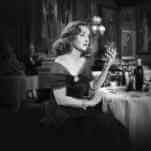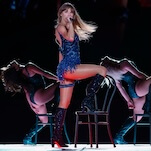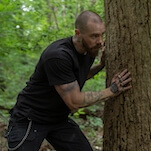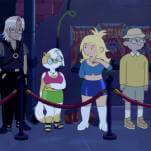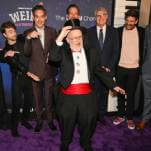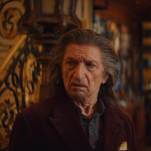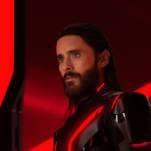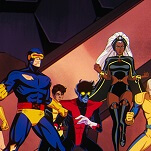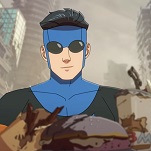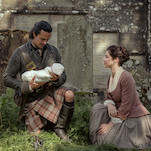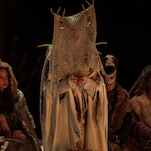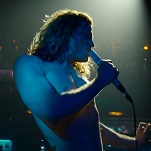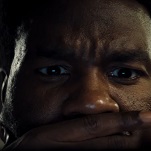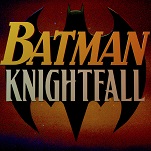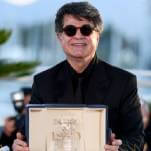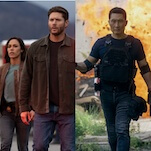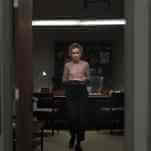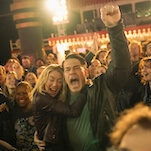Starting this week, our coverage of superhero/mainstream comics and graphic novels/art comics combines into the new bi-weekly Comics Panel, featuring recent notable releases along the entire comics spectrum.
Rick Remender’s Uncanny X-Force was a surprisingly nuanced book in spite of heavy violence, and while the title’s Marvel Now! relaunch lacks the storytelling subtleties of Remender’s run, it’s one damn entertaining action comic. Catching up with Psylocke six months after the end of the last volume, Sam Humphries and Ron Garney’s Uncanny X-Force #1 (Marvel) teams Betsy Braddock with a newly mohawked Storm (see the outstanding Wolverine And The X-Men #24) and the diminutive Puck of Alpha Flight to take down the six-armed, drug-dealing Spiral. Humphries’ Psylocke is more aggressive and foul-mouthed than her previous portrayal, and the big mystery of this issue is what exactly went down in the six months since Betsy got her happy ending with a revived Fantomex. And then there’s this issue’s outrageous cliffhanger, which has Fantomex pulling in his female clone Cluster for a kiss, which is just creepy. Humphries broke into the industry with a book about people having sex with dogs and crystals (Our Love Is Real), so it’s nice to see that bizarre sensibility make its way into the X-universe. This is one of the strangest X-Men lineups in recent history, but Humphries makes a strong case for bringing these characters together, even if he’s still a ways away from making them a full-fledged team.
Action is the name of the game for X-Force, and Ron Garney knows how to stage dynamic fight sequences. Marte Gracia has been doing great work coloring All-New X-Men, and his colors make Garney’s art pop on the page, using a palette that emphasizes pinks and purples, which happen to be Psylocke’s signature hues. The most striking thing about the artwork is Kris Anka’s costume designs, which are graphic and functional but still sexy, giving Psylocke and Storm their best looks in years. The return of Storm’s mohawk is a strong way to visualize her personality shift after the annulment of her marriage to the Black Panther, and Psylocke has finally graduated from wearing a one-piece bathing suit to a bodysuit with a piece of fabric around the waist. The new Uncanny X-Force is a much different beast than what came before, but for those who like their X-titles action-packed with a big WTF factor, this is the book… [OS]
Peter Bagge brings together two of his regular themes—celebrity and technology—in Reset (Dark Horse Originals), easily his strongest sustained-narrative comic since his mid-’90s Hate heyday. Originally published as a four-issue miniseries last year, the now-collected Reset follows a has-been comic actor named Guy Krause who gets invited to participate in an unusual virtual-reality project, which will take him back to key events in his life and give him the opportunity to make different choices. In typical Bagge fashion, the premise quickly becomes incidental. Rather than playing along, Guy questions every aspect of the project, and soon uses the program to indulge his worst narcissistic impulses, while Angie, the scientist managing the experiment, tries to keep him on task and keep herself employed.
Bagge has explored some of this territory before, most notably in his 2010 graphic novel Other Lives, though in that book, he seemed to have an endpoint in mind, and pushed his characters along their paths in ways that ran counter to his strengths as a storyteller. With Reset, Bagge is back on his game, getting into the heads of Guy and Angie and letting them dictate what happens. And that’s appropriate, since much of Reset is about the difference between the constructed nature of stories and the unpredictability of real life. It’s also about voyeurs and exhibitionists, and what each expects from the other, in terms of the latter being “interesting” and the former paying proper attention. Reset is funny, of course—Bagge’s comics are nearly always funny. But like the best of Bagge’s work, the book also tries to get at something true about modern life, as Guy and Angie figure out how to move beyond the pervasive, nagging dissatisfaction of their culture… [NM]
Eisner Award winner Francesco Francavilla became one of the industry’s top talents with his work on Detective Comics, Black Panther, and a bunch of eye-catching covers, and it turns out that his writing is just as strong as his artwork. The Black Beetle #1 (Dark Horse) is one of the most exhilarating, stunning superhero comics on the stands, spotlighting the defender of Colt City as he investigates the bombing of a club that kills some of the city’s most notorious criminals. Picking up after the hero’s introduction in the pages of Dark Horse Presents (also available as Black Beetle: Night Shift #0), this miniseries presents a high-stakes mystery realized through Francavilla’s intensely graphic style, full of innovative layouts and spectacular splash pages. Splash-heavy books can feel slight on the story side, but Francavilla fills each page with information, creating a riveting, dense read.
The credits say the book is “written and directed” by Francavilla, who channels film-noir greats like John Huston, Alfred Hitchcock, and John Alton with his cinematic, chiaroscuro-heavy artwork. His design for the main character combines the best elements of Batman and the Blue Beetle, and although the hero is given no backstory, he makes up for it in personality. Little touches—like the slightest hint of a grin when Black Beetle knocks out a group of armed guards with poison darts—go a long way toward establishing his attitude, that of a hero who kicks ass while retaining a sense of humor. Francavilla’s high-contrast color palette of red and blue gives the book a distinct look, and lends added importance to flashes of different colors, like the book’s yellow villain. Dark Horse has been publicizing this book as “super noir,” and it’s a must-read for fans of either genre. It’s always welcome to see Francavilla bring his unique voice to the heroes of Marvel and DC, but he’s created something truly magical with the Black Beetle, and hopefully this hero has a long, full life ahead of him… [OS]
Frank Cho loves breasts and dinosaurs, so it should come as no surprise that his Savage Wolverine #1 (Marvel) is chockfull of both. The first of two Marvel Now! Wolverine titles, Savage is going for a pulp-inspired vibe, throwing Wolverine into the Savage Land, where he teams up with the bikini-clad Shanna the She-Devil to fight intelligent Neanderthals and humanoid pterodactyls. It’s a bit incongruent to see Wolverine chopping men to pieces when he’s actively trying to be less of a killer in the pages of Wolverine And The X-Men and Uncanny Avengers, but this is Savage Wolverine, not Wolverine: The Hugging Mutant, so it works in context. Chris Eliopoulos’ design work on the recap and letter pages contributes to the retro feel, with bold graphic lettering printed on paper made to look aged and wrinkled. And the emphasis on a classic pulp tone makes it a little easier to swallow the fact that Wolverine’s partner is wearing a leopard-print bikini.
Cho is one of comics’ finest cheesecake artists, but while his Shanna is incredibly sexualized, she’s never vulnerable, and she poses just as much of a threat as the title character. Cho is telling a fun adventure story, but his artwork is the highlight of the issue, gorgeously detailed with intuitive layouts that capture the brutality of the action. Whether he’s drawing the Savage Land’s lush vegetation, the scales on an attacking velociraptor, or the seams on Wolverine’s costume, every panel is meticulously realized. Unfortunately, that level of attention means Cho has a history of being a slow artist; ideally, he has most of this initial storyline already finished so the book isn’t plagued by delays… [OS]
What happens when you get Raptured on a clerical error and get sent back to Earth for being a total shithead? If you’re Bram Carlson, you take advantage of the situation and declare yourself the Antichrist before anyone else hogs the glory. James Asmus, Jim Festante, and Rem Broo’s The End Times Of Bram And Ben #1 (Image) is a hilarious look at the biblical apocalypse through the eyes of two roommates left behind, a witty, deliciously offensive book that ruthlessly attacks Christian beliefs. Heaven is a place filled with fat old people who never sinned because they couldn’t find anyone to sin with, and are forced to eat manna and praise the Lord all day; angels are hunchbacked senior citizens who don’t realize they’re using sexual euphemisms in their attempts to convert the wicked.
Writers Asmus and Festante pack a lot of content into this first issue, establishing Bram’s brash, shameless attitude and his roommate’s more anxious, guarded personality, creating a compelling buddy comedy with a foundation in epic catastrophe. Broo’s artwork is in the same vein as Chew’s Rob Guillory, cartoonishly exaggerated yet highly detailed, creating expressive characters and immersive environments while nailing all the comedy of the script. When the story calls for huge fantasy visuals, like a two-page spread depicting a battle between heaven and hell, Broo delivers energetic, imaginatively designed visuals in strong contrast to the rest of the down-to-earth content… [OS]
Also…
Todd, The Ugliest Kid On Earth (Image) could easily exist in the same universe as The End Times Of Bram And Ben, although Kris Kristensen and M.K. Perker’s title has a more disturbing tone, with its tale of child murder and the lonely little boy that becomes Suspect No. 1. A roll-call page on the inside cover provides a hefty amount of joke-filled exposition, a shortcut that lets the creator jump right into the story. Some of the humor can be a little too much, like the repetition of the police chief’s inability to walk down the Candie (Barbie) aisle at the toy store because it gives him an erection, but there are some great lines. (Todd’s dad on Obama endorsing gay marriage: “See, all presidents try to legalize torture. Obama’s way is to legally torture gays by allowing them to marry.”) What the book does best is capture Todd’s loneliness, primarily accomplished without the use of text. Perker’s artwork has a grotesque edge, bringing an ugliness to the world that is probably far worse than whatever is concealed under the paper bag over Todd’s head… [OS]
The 28-page one-shot House Of Fun (Dark Horse) is in the spirit and style of Evan Dorkin’s old comic-book series Dork, collecting stories and gags Dorkin contributed to other publications (mostly Dark Horse Presents) over the past few years. Dorkin’s range hasn’t expanded much since Dork #11 came out in 2006. House Of Fun brings back pretty much all of Dorkin’s regulars: the run-amok icons Milk and Cheese, the serial-killing sitcom stars The Murder Family, and the aggressively nerdy Eltingville Comic Book, Science-Fiction, Fantasy, Horror And Role-Playing Club. But Dorkin hasn’t forgotten how to make these characters amusing, either, as he uses them to comment on everything from the zombie craze to the banality of mass media. House Of Fun is also peppered with the short strips that have been Dorkin’s strongest work over the years: little four-panel throwaways in which he strives to be as silly and/or inappropriate as possible, while riffing on popular culture and the conventions of the comics medium. Dorkin has long been one of the most distinctive cartoonists of his generation, with a grasp of comedic pacing and basic page and panel design as accomplished as his ability to draw cute-but-creepy cartoon characters. And while House Of Fun isn’t as good as Dorkin’s peak, it’s a fine reminder of the years when Dork was the most reliably funny comic-book series around, before Michael Kupperman’s Tales Designed To Thrizzle stole that title… [NM]
A few years after Gold Key began publishing Tarzan comic books, the company started using the series to adapt Edgar Rice Burroughs’ original novels, with Gaylord DuBois providing the scripts and Russ Manning doing the art. Edgar Rice Burroughs’ Tarzan: The Russ Manning Years, Volume One (Dark Horse Archives) collects seven of those adaptations, spread across 11 issues published between 1965 and 1967. As with the other volumes in Dark Horse’s Tarzan archives, the publisher does justice to this material, adding a Sergio Aragonés introduction and reconstructing the color of the comics rather than merely reprinting the muddy originals. This makes a huge difference with Manning’s subtle linework, which isn’t as bold or dynamic as most ’60s adventure comics. Manning’s humans and animals strike realistic poses, similar to Burne Hogarth’s classic Tarzan comic strip, but less fussy. And DuBois’ scripts tell Burroughs’ stories straightforwardly, not shying away from their violence or sensuality. These comics are more than half a century old, and their source material even older, and yet they still feel modern… [NM]
Bringing in Keith Giffen, a contributor to Marvel’s Annihilation miniseries, to flesh out the cosmic corner of the DC universe is a smart move, but Threshold #1 (DC) is a disappointing start to a title that’s supposed to be the bedrock of the company’s space stories. This title spins out of the Green Lantern: New Guardians Annual, and hopefully readers have checked out that book, because not much info is provided about this book’s lead: a renegade Green Lantern named Caul. He’s one of many criminals featured on The Hunted, a televised bounty hunt with hints of Marvel’s Mojo World, complete with a slimy green guy running things behind the scenes. The plot lacks a strong hook, and the alien dialogue is flat-out ridiculous (“You ever clap an orb on their top muck?”), but Tom Raney provides strong artwork with fluid action and well-rendered environments. The backup tale spotlighting Orange Lantern Larfleeze goes for more of a comedic angle, but Larfleeze is a one-note character whose entire shtick is that he’s greedy and self-absorbed. Scott Kolins is embracing a more animated style with his art in the backup, but there isn’t much substance to the story. And things don’t look to get much better in future issues, with DC reviving Captain Carrot as a blatant Rocket Raccoon rip-off called Captain K’Rot. There’s so much potential in DC’s cosmic character, but Threshold barely scratches the surface… [OS]
Some of the best fantasy stories test how a far-out idea would work in real life. Writer Jean-Luc Cornette and artist Stéphane Oiry do this eight times over in Through The Walls (Humanoids), imagining a world in which a handful of people have developed the power to pass through solid objects, then crafting elliptical short stories about how these people would put their talent to use. Rather than fighting crime—or committing crimes—the ordinary Europeans in Through The Walls focus on more mundane tasks, like spying on a beautiful coworker, or removing an object blocking a pet’s digestive tract. The eight stories in Through The Walls range from whimsical to heartbreaking, with a twist or two along the way, all rendered by Oiry in a light, colorful, scratchy style. These pieces are all just variations on a theme, but Cornette has a fertile idea here, and gets a lot from it… [NM]
Three years ago, Fantagraphics published the Moto Hagio anthology A Drunken Dream, introducing many American comics fans to the woman who helped bring the female-friendly “shōjo” manga into its new maturity in the ’70s. Now Fantagraphics is releasing The Heart Of Thomas, one of Hagio’s most popular and influential book-length stories, about raging hormones and dark secrets at a German boarding school. A quintessential example of the “boys love” (or “shōnen-ai”) shōjo subgenre, The Heart Of Thomas begins with a popular teenager falling to his death off a bridge, after a leaving a love note to a standoffish classmate. Then a sheltered lad who looks just like the dead student arrives at the school, and a new round of romantic drama—or “farce,” in these kids’ parlance—threatens to expose truths that students and teachers alike have desperately tried to keep concealed. The Heart Of Thomas requires an initial adjustment period from readers, as Hagio’s penchant for drawing boys that look like girls—and her unwillingness to use words like “gay,” or even to presume that anything taboo is happening—confuses the nature of these relationships. But it helps that The Heart Of Thomas was originally published in serialized form, with small cliffhangers at the end of each chapter to pull readers deeper into Hagio’s fantasyland. The intrigue deepens page by page (and this is a 500-page novel, mind), while Hagio develops her bracingly radical vision of a mini-society where homosexual attraction is so commonplace as to be the norm… [NM]
It’s appropriate that a book called The Answer would be full of questions, but that’s what makes the new miniseries by Dennis Hopeless and Mike Norton so alluring. The Answer #1 (Dark Horse) follows Devin McKenzie, a librarian who has a flawless Jeopardy! record and knows every crossword clue, but when she unlocks an extremely difficult puzzle ball in a matter of minutes, she ends up in a life-or-death problem that she has no idea how to solve. Her only ally is a superhero with an exclamation point on his mask and the ability to come back from a gunshot wound to the head. He helps her as she makes her escape from armed thugs that are somehow connected to a self-help group devoted to chaos. Hopeless’ snappy dialogue gives Devin a sassy personality that doesn’t undercut her intelligence, and the story he’s crafted with Norton smoothly transitions between mystery, suspense, action, and humor. Norton is one of the industry’s most reliable pencillers, and he provides sharp visuals that balance the script’s various genre elements. Readers looking for an intriguing superhero tale outside of Marvel and DC will find it in The Answer, which, along with The Black Beetle, is ushering in a year of memorable costumed adventures at Dark Horse… [OS]
Back when The Comics Journal was a (mostly) monthly publication, each edition was so packed with in-depth interviews, thoughtful essays, and challenging reviews that it was almost impossible to finish one issue before the next one hit the stands. That hasn’t really changed now that the Journal has gone annual. The Comics Journal #302 (Fantagraphics) is a magnificent brick of a book, highlighted by an 80-page interview between editor Gary Groth and illustrator Maurice Sendak, conducted a few months before Sendak died. More a winding conversation than a proper TCJ interrogation, the Groth/Sendak chat is nonetheless lively, with Sendak couching some highly provocative comments about art and politics in “What have I got to lose?” candor (including how he would’ve killed George W. Bush if he’d been braver). The Sendak interview is flanked by critical appreciations, which, combined with the interview, only take up about a sixth of this nearly 700-page issue. The rest of TCJ #302 includes a long Jacques Tardi interview (plus critical essay), a rare non-journalistic Joe Sacco comic-book story, a biography of Robert Crumb’s lawyer, a history of the Senate’s investigation into comic books in the ’50s, roundtables on kids’ comics and art-comics, and more. In other words: business as usual for a publication that was treating the cultural significance of comics as a known fact decades before graphic novels were making the bestseller list. [NM]


